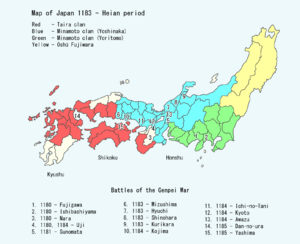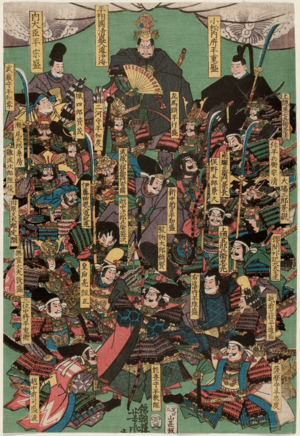Taira clan facts for kids
Quick facts for kids Taira平氏 |
|
|---|---|

Mon: Agehachō, the Swallowtail butterfly
|
|
| Home province | Hitachi Province, Ise Province |
| Parent house | Imperial House of Japan |
| Titles | Various |
| Founder | Taira no Takamochi |
| Final ruler | Taira no Munemori |
| Founding year | c. 825 |
| Cadet branches | Hōjō Chiba Miura Nagao Uchima Tajiri Hatakeyama Oda Tanegashima others |
The Taira (平) was a very powerful family in ancient Japan. They were one of four big clans that shaped Japanese history for hundreds of years. These periods were the Heian, Kamakura, and Muromachi eras. The other major clans were the Minamoto, the Fujiwara, and the Tachibana.
The Taira family had four main branches. Each branch was named after an emperor they were related to. These branches were Kanmu Heishi, Ninmyō Heishi, Montoku Heishi, and Kōkō Heishi.
People often called the Taira clan Heishi (平氏, "Taira clan") or Heike (平家, "House of Taira"). The word hei means "Taira," shi means "clan," and ke means "extended family."
Contents
The Taira Clan's Story
The Taira clan, along with the Minamoto, got their name from the emperors. During the Heian period (794–1185 CE), emperors gave these special names to their children and grandchildren. This happened if they were not going to become emperor themselves.
The clan started because the Imperial Court in Kyoto became too big. The emperor decided that some descendants of past emperors would no longer be princes. Instead, they would get noble family names and ranks. This rule began during the time of Emperor Kanmu (782–805). This is how the Taira clan and the Minamoto clan were created.
How the Taira Clan Grew
Some grandchildren of Emperor Kanmu were the first to be called Taira, starting around 825. Later, descendants of Emperor Nimmyo, Emperor Montoku, and Emperor Koko also received this family name. Each of these family lines is known by the emperor's name, like Kanmu Heishi.
The Kanmu Heishi line became the most powerful. It was started in 889 by Taira no Takamochi. He was the great-grandson of the 50th Emperor Kanmu.
A later member of this line, Taira no Kiyomori, created Japan's first samurai government. A great-grandson of Takamochi, Taira no Korehira, moved to Ise Province. This area is now part of Mie Prefecture. He started an important family of Daimyo, who were powerful lords.
His grandson, Taira no Masamori, and great-grandson, Taira no Tadamori, were loyal to the emperors. They supported Emperor Shirakawa and Emperor Toba.
Taira no Kiyomori's Rise to Power
Taira no Kiyomori was the son of Tadamori. He became a very important minister, called Daijō Daijin. He earned this position after winning battles in the Hōgen rebellion (1156) and the Heiji Rebellion (1160).
In 1180, Kiyomori made his youngest grandson the new emperor, Emperor Antoku. This action led to a big war called the Genpei War (1180–1185). The last leader of the Kanmu Heishi line was eventually defeated. This happened at the Battle of Dan-no-ura by the armies of Minamoto no Yoritomo. This famous story is told in the book Heike Monogatari.
Many other important families came from this Kanmu Heishi branch. These include the Hōjō, Chiba, Miura, and Hatakeyama clans.
Another important person from this family was Takamune-ō. He was the eldest son of Prince Imperial Kazurahara. He received the Taira name in 825. So, there were two main groups in Kanmu Heishi. One group came from Takamune, and the other from his nephew, Takamochi.
The Oda clan also said they were related to the Taira. This was during the time of Oda Nobunaga (1534–1582). They claimed to be descendants of Taira no Chikazane.
The Genpei War
During the Heiji Rebellion in 1160, the leader of the Minamoto clan, Minamoto no Yoshitomo, died. Taira no Kiyomori then gained much power in Kyoto. He made strong alliances with retired emperors Shirakawa and Toba. Kiyomori sent Minamoto no Yoritomo (1147–1199), Yoshitomo's son, away into exile.
In 1180, Yoritomo started a large rebellion against the Taira family. This was the Genpei War. This war ended with the Minamoto clan defeating the Taira. They took control of eastern Japan in five years. In 1192, Minamoto no Yoritomo became the first shogun. He created the first military government, called a bakufu, in Kamakura.
Main Taira Branches
The Taira clan had four main family lines:
- Taira Kanmu (Kanmu Heishi, 桓武平氏) – These were descendants of the children of the 50th Emperor Kanmu.
- Taira Nimmyō (Nimmyō Heishi, 仁明平氏) – These were descendants of the grandchildren of the 54th Emperor Nimmyō.
- Taira Montoku (Montoku Heishi, 文徳平氏) – These were descendants of the children of the 55th Emperor Montoku.
- Taira Kōkō (Kōkō Heishi, 光孝平氏) – These were descendants of the grandchildren of the 58th Emperor Kōkō.
Important Taira Clan Members
Here are some important people from the Taira clan:
- Taira no Takakiyo (1173–1199)
- Taira no Kiyomori (1118–1181)
- Taira no Shigehira (1158–1185)
- Taira no Tomomori (1152–1185)
- Taira no Munemori (1147–1185)
- Taira no Shigemori (1138–1179)
- Taira no Tadanori (1144–1184)
- Taira no Masakado (903–940)
The Taira Family Symbol
The mon (family crest or emblem) of the Taira clan is a swallowtail butterfly with its wings raised. It is called an Agehanochō (揚羽蝶).
Images for kids
-
Yoshitsune and Benkei defending themselves in their boat during a storm created by the ghosts of conquered Taira warriors (by Utagawa Kuniyoshi)
See Also
 In Spanish: Clan Taira para niños
In Spanish: Clan Taira para niños
- Japanese name
- Japanese clans
- Taira no Masakado




